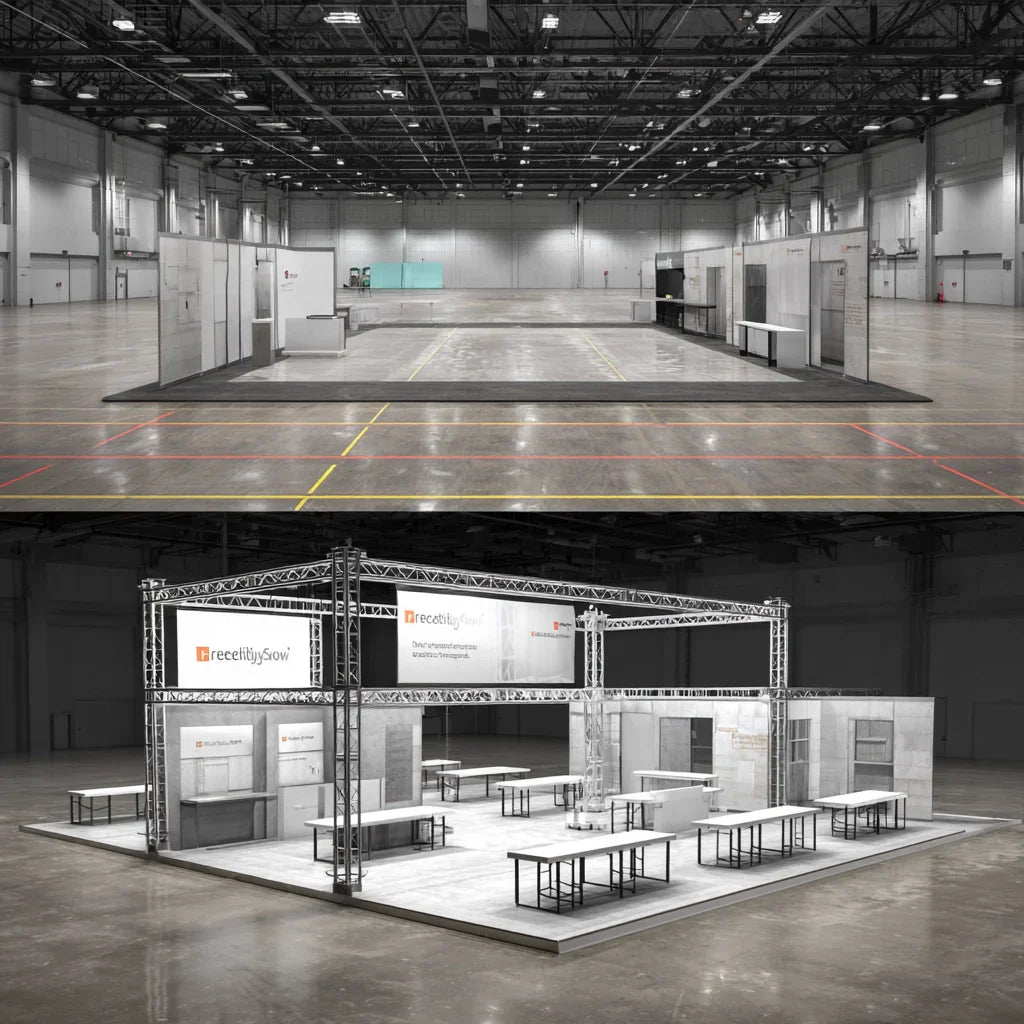
The Secret to a Captivating Trade Show Booth: A Complete Guide to Designing a Memorable Exhibition Stand from Scratch
When visiting a trade show, have you ever found yourself drawn to a booth with a clever setup or unique display? That irresistible pull is rarely accidental. A successful trade show booth idea goes beyond flashy visuals—it’s a strategic design decision rooted in psychology, branding, and functionality. A well-designed booth becomes a silent salesperson: grabbing attention, drawing foot traffic, and sparking conversations.
Today, we’ll unlock the secrets behind professional booth planning—from goal-setting to layout execution—so your space becomes one of those booths attendees can’t help but walk into. Whether you're brainstorming booth setup ideas or fine-tuning lighting plans, this guide ensures your booth attracts, engages, and converts.
I. Before Designing: Clarify “Why You’re Exhibiting”
Booth design starts with strategy—not decoration. Before choosing your decorating ideas vendor booth ideas, ask yourself: What is the purpose of this exhibition?
1. Tailor Design to Your Goals
-
For product launches, highlight a stage-like display area or incorporate interactive screens.
-
For brand exposure, create high-frequency visual cues (logo, brand colors, slogans).
-
For client meetings, design a quiet corner for negotiations, smoothly connected to the main booth.
For instance, if you're building an island booth design at a lifestyle expo, where traffic flows from all directions, your layout must maximize visibility and allow seamless navigation across all zones.
2. Communicate Precisely with Designers
Avoid revision loops by preparing:
-
Basic specs: Booth size, height caps, open sides (island or linear), and fire regulations.
-
Brand direction: Core colors, tone (e.g., techy or natural), and design preferences.
-
Product features: For example, use reinforced flooring for heavy machinery or power planning for devices.
II. Visual Design: Grab “First Glance Attention” in 3 Seconds
Visitors pass dozens of booths per minute. The window to capture attention is tiny—so your design must speak loud and clear.
1. Color: The Rule of Three
Stick to the 60/30/10 formula: 60% main brand color, 30% accent, 10% neutral.
Too many hues overwhelm. Instead, choose a palette that pops while keeping coherence. This makes your booth easier to remember—and photograph.
2. Shape & Structure: Create Layers and Movement
From floating lightboxes to curved walls, structure can enhance presence. Consider adding:
-
Tiers of product stands for layered visibility.
-
Hanging banners or tension fabric backdrops that draw eyes upward.
-
Transparent walls for space without obstruction.
These elements aren’t just visually compelling—they’re also modular, ideal for a trade show portable display setup.
3. Lighting: Highlight What Matters
Lighting is one of the most powerful (and cost-effective) design tools. Use it to differentiate areas:
-
Spotlights for displays
-
Soft ambient lights in meeting zones
-
RGB interactive lights in product demos
Your lighting plan should echo your brand personality and highlight core features.
III. Layout Logic: Make Visitors “Enter, Explore, and Stay”
Smart layouts don’t just look good—they guide behavior. Think of your booth like a mini journey from curiosity to engagement.
1. Flow Design: Invite Exploration
Attract attention at the entrance with video walls or sensors that trigger content. Then, guide people using arrows, decals, or light paths—ideally moving them from new product displays to interaction zones, then into rest or negotiation areas.
If space permits, consider including a portable display table near high-traffic corners, ideal for literature or light demos without blocking flow.
2. Functional Zones: Cover All Needs
Organize your booth into:
-
Product zone: Use stands, touch screens, and AR elements.
-
Storytelling zone: Display your brand journey using interactive props or raw material exhibits.
-
Lounge area: Comfy seats, charging stations, refreshments.
By separating functions clearly, your booth satisfies both casual browsers and serious prospects.
IV. Details That Make You Memorable
Sometimes, the smallest touches generate the biggest buzz.
1. Interaction is Key
Fun, low-barrier interaction ideas include:
-
Scan-to-play product simulations
-
Social media check-ins for free samples
-
Digital quizzes with branded giveaways
These ideas work especially well in younger markets or fast-moving consumer goods.
2. Brand Every Inch
From custom uniforms to branded pens or water bottles, consistent visuals matter. Even tension fabric backdrops can be printed with subtle cues or brand icons.
When your visual identity extends from space to staff, visitors will remember your presence—long after the show ends.
Conclusion: Build a Booth that Sells and Sticks
At the end of the day, your booth should do three things:
-
Grab attention
-
Encourage engagement
-
Build brand memory
Whether you’re working with a compact modular setup or a full-scale island booth design, the principles remain the same. A great trade show display idea is one that serves your goals and creates moments people want to share.
So next time you’re brainstorming trade show display ideas, remember: function fuels form. A beautifully executed trade show portable display—combined with strategic layout, thoughtful storytelling, and interactive touchpoints—is what transforms visitors into leads and leads into loyal customers.
If you need, please contact us:
WhatsApp:+8615220114725 Quicklyshow Alice
WhatsApp:+8613380363717 QuicklyShow Helen
